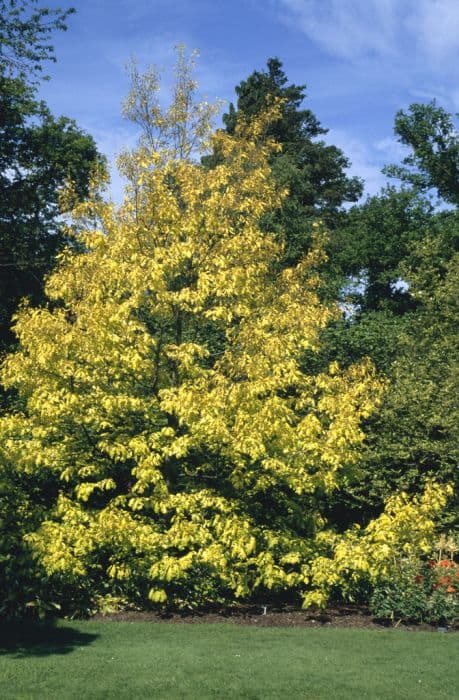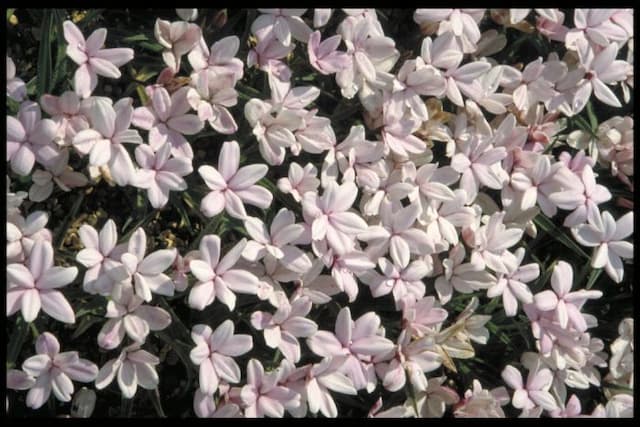Red star Rhodohypoxis milloides

ABOUT
The plant with the common name Rhodohypoxis milloides is a small perennial known for its clumping habit and attractive flowers. The plant forms dense tufts of narrow, lance-shaped leaves that are green and may have a slightly hairy appearance. Its foliage provides a lush, grass-like background for the star attraction—its blooms. The flowers of this plant are quite distinctive and beautiful, typically emerging in the late spring to summer period. They are shaped like small stars or cups and come in shades of pink, red, or white, often with a hint of other colors at the base of the petals. Each flower appears on a short stalk that rises just above the foliage, creating a delicate display that seems to float above the green leaves. The blooming period results in a carpet of color, making it a favorite for gardeners looking to add a splash of brightness to rock gardens, borders, and alpine displays. The overall effect of Rhodohypoxis milloides when in flower is one of softness and charm, with the flowers providing a gentle contrast against the greenery. This ground-covering plant has a compact form, and its texture and color can add visual interest and variety to any planting area without overpowering other garden elements. The plant is also known to be hardy and can handle a variety of conditions, but it thrives best in areas where it can receive plenty of light and have soil that drains well.
About this plant
 Names
NamesFamily
Hypoxidaceae
Synonyms
Red Star, Rhodohypoxis, Rose Grass, Star Flower
Common names
Rhodohypoxis baurii var. platypetala, Hypoxis milloides.
 Toxicity
ToxicityTo humans
Rhodohypoxis baurii, commonly known as the Rhodohypoxis, is not known to be toxic to humans. Consequently, ingestion of this plant typically does not result in poisoning or adverse health effects. However, it is always advisable to exercise caution and avoid eating plants not known to be edible, as individual allergic reactions or stomach discomfort may occur.
To pets
The Rhodohypoxis baurii, often referred to as Rhodohypoxis, is not documented as a toxic plant to pets either. It does not contain known toxins that could cause harm to animals if ingested. Nonetheless, pet owners should discourage their pets from consuming non-food plants, as they can sometimes cause gastrointestinal upset or an allergic reaction in sensitive individuals.
 Characteristics
CharacteristicsLife cycle
Perennials
Foliage type
Deciduous
Color of leaves
Green
Flower color
Varies
Height
6 inches (15 cm)
Spread
6 inches (15 cm)
Plant type
Bulb
Hardiness zones
7
Native area
South Africa
Benefits
 General Benefits
General Benefits- Aesthetic Appeal: Rhodohypoxis baurii, commonly known as Rhodohypoxis, adds visual interest to gardens with its showy pink, red, or white flowers.
- Low Maintenance: The plant is relatively easy to care for, requiring minimal attention once established in the right conditions.
- Ground Cover: Dense growth habits make it an excellent ground cover, suppressing weeds and reducing soil erosion.
- Attracts Pollinators: The flowers of Rhodohypoxis attract beneficial insects like bees, which are vital for pollination in the garden.
- Seasonal Interest: Rhodohypoxis blooms during late spring and summer, providing seasonal interest in the garden when many other plants may not be flowering.
- Compact Size: Its small size makes it suitable for rock gardens, borders, and small spaces where larger plants would overwhelm.
- Container Gardening: Rhodohypoxis is well-suited to container gardening, allowing those with limited space to enjoy its beauty on patios or balconies.
 Medical Properties
Medical Properties- This plant is not used for medical purposes
 Air-purifying Qualities
Air-purifying QualitiesThis plant is not specifically known for air purifying qualities.
 Other Uses
Other Uses- Rhodohypoxis baurii, commonly known as the red star or rosy posy, can be used in fairy gardens due to its small size and attractive flowers, creating a whimsical miniature landscape.
- The plant can be placed in terrariums with adequate light as a low-growing element that adds color and diversity to the miniature ecosystem.
- They can serve as a living mulch in garden beds, where their dense growth can help suppress weeds while adding aesthetic appeal.
- Rhodohypoxis baurii can be used as a natural dye source for fabrics, with the potential to extract hues from its vibrant flowers.
- In small-scale landscaping, the plant can be used to create colorful borders along walkways or edges of garden patches.
- The flowers of the red star can be used as edible decorations for salads and desserts, offering a unique touch to gourmet presentations.
- When dried, the blossoms can be incorporated into potpourri mixes, contributing a natural and subtle fragrance as well as color.
- They can be used in alpine rock gardens to simulate the natural growing conditions of mountainous regions and to bring delicate beauty to rugged landscapes.
- As a companion plant, red star can be grown alongside vegetables like lettuce or radishes, as its blooming can attract pollinators to the garden.
- The plant can be a subject of botanical illustration and photography due to its distinctive flowers, inspiring both art forms.
Interesting Facts
 Feng Shui
Feng ShuiThe plant Rhodohypoxis baurii, commonly known as Rhodohypoxis, is not used in Feng Shui practice.
 Zodiac Sign Compitability
Zodiac Sign CompitabilityThe plant Rhodohypoxis baurii, commonly known as Rhodohypoxis, is not used in astrology practice.
 Plant Symbolism
Plant Symbolism- Awareness: Rhodohypoxis baurii, commonly known as "Red Star," often symbolizes awareness due to its star-shaped flowers that seemingly point outwards in multiple directions.
- Interest in the Small Wonders: As a small plant with delicate features, the Red Star can represent an appreciation for the subtler beauties in life, reminding us to take joy in the small wonders.
- Resilience: Despite its delicate appearance, Red Star is relatively hardy and can symbolize resilience and the ability to thrive in challenging conditions.
 Water
WaterRed star plants require moderate watering, being careful not to overwater as they prefer well-drained conditions. During the growing season in spring and summer, water the plant once a week with approximately one gallon of water each time, making sure the soil becomes moist but not soggy. Reduce the frequency of watering to every other week in the fall. Winter is a dormant period for the red star; therefore, watering should be minimal, just enough to prevent the soil from completely drying out.
 Light
LightRed star plants thrive in full sun to partial shade, so place them in a spot where they receive at least four to six hours of sunlight daily. They can tolerate light shade, especially in the hottest part of the day, but too much shade may reduce flowering. The ideal spot would be one where morning sunlight is abundant and some dappled afternoon shade is available to protect them from intense heat.
 Temperature
TemperatureRed star plants are hardy and can tolerate a temperature range between 20 to 75 degrees Fahrenheit. They can survive short periods of frost, but prolonged exposure to temperatures below 20 degrees can be detrimental. The ideal growing temperature for red stars is between 50 and 70 degrees Fahrenheit, ensuring optimal growth and flowering.
 Pruning
PruningPruning red star plants isn't typically necessary, but faded flowers can be deadheaded to encourage further blooming. If the plant becomes overgrown or untidy, prune it lightly after the blooming period, usually in late summer. This will help maintain the plant's shape and remove any damaged or spent foliage.
 Cleaning
CleaningNot needed
 Soil
SoilThe best soil mix for Rhodohypoxis baurii, commonly known as the red star, should be rich in organic matter, well-draining, and slightly acidic to neutral, with a pH of around 5.5 to 7. A mixture of peat, loam, and sharp sand or perlite is ideal to ensure good drainage and aeration around the roots.
 Repotting
RepottingRhodohypoxis baurii, or red star, should be repotted every two to three years to refresh the soil and accommodate root growth. It's best to repot these plants in the spring just as new growth begins, carefully dividing clumps if necessary.
 Humidity & Misting
Humidity & MistingRhodohypoxis baurii, the red star, prefers moderate to high humidity levels. Despite being drought-resistant, it thrives best with ambient humidity, particularly during its active growth phase in the spring and summer.
 Suitable locations
Suitable locationsIndoor
Place red star in bright light, ensure good ventilation, and keep soil moist.
Outdoor
Plant red star in part sun, with moist, well-drained soil, and protect from harsh winter.
Hardiness zone
7-9 USDA
 Life cycle
Life cycleRhodohypoxis baurii, commonly known as Rhodohypoxis or Red Star, typically begins its life cycle when seeds germinate in spring, given the right conditions of moisture and temperature. The plant develops a rosette of narrow, grass-like leaves and establishes a root system. Throughout late spring and summer, it produces small star-shaped flowers in shades of red, pink, or white. Rhodohypoxis grow actively during these warmer months when there is ample sunlight. As temperatures drop and the plant enters autumn, it starts to die back, with above-ground foliage withering, indicating the onset of dormancy. During winter, the plant survives as small corms underground and will re-sprout the following spring, continuing its perennial cycle.
 Propogation
PropogationPropogation time
Early spring
Rhodohypoxis baurii, commonly known as Red Star, can be easily propagated by dividing its small corms or tuberous roots during the plant's dormant period, usually in late summer or autumn. To propagate by division, the clumps of the plant should be carefully lifted from the soil and the corms gently separated by hand, making sure that each division has at least one growth point. These individual corms can then be replanted immediately in well-draining soil at a depth of about 1 to 2 inches (2.5 to 5 cm), spacing them about 3 inches (approximately 7.6 cm) apart. It's important to water the newly planted corms lightly to help establish them, but avoid waterlogging as Red Star is prone to rot in overly moist conditions. With proper care, these divisions will grow into healthy plants by the next flowering season.
![Rhodoxis [Fairytale]](/_next/image?url=https%3A%2F%2Fplants-admin.emdemapps.com%2Fimages%2Fplants%2F%2Fimages%2F604b54204420d.png&w=640&q=75)



